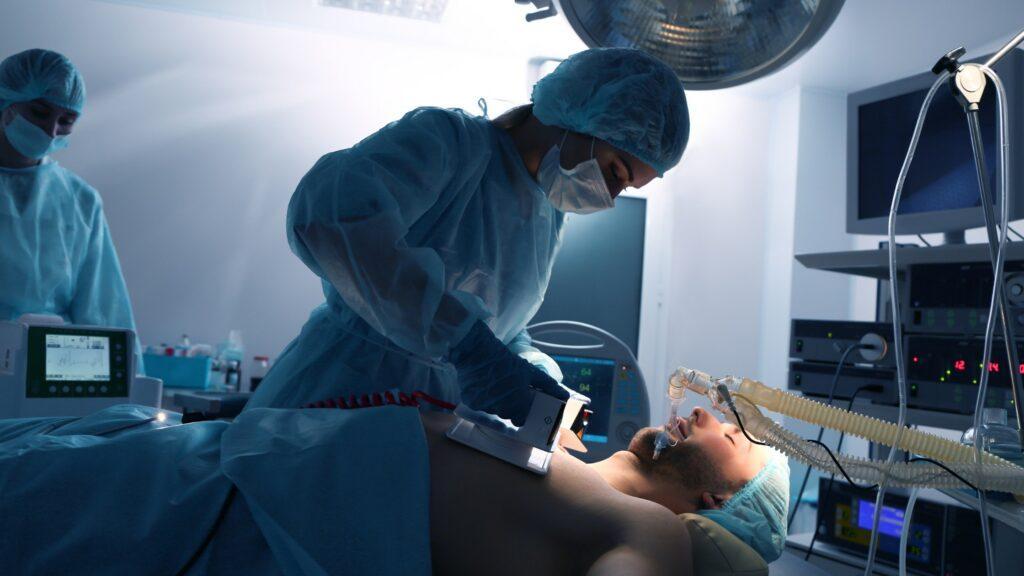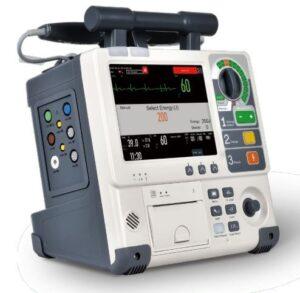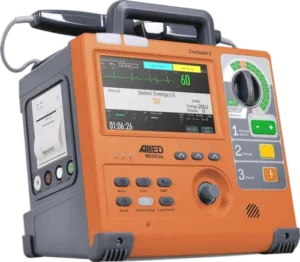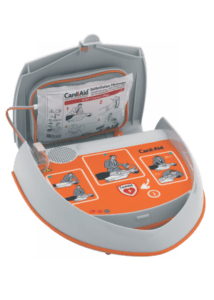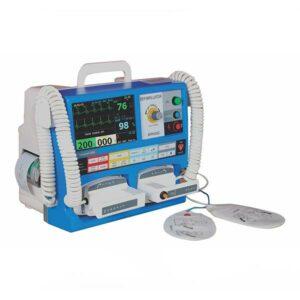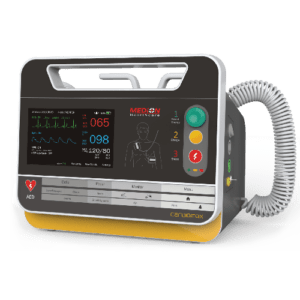Defibrillators are emergency medical devices designed to deliver an electric shock to the heart in order to restore its normal rhythm during a cardiac arrest or certain life-threatening arrhythmias. These devices are crucial in emergency situations where the heart’s electrical system becomes disrupted, leading to irregular and ineffective pumping of blood.
A defibrillator consists of several key components, including a power source, control panel, and electrodes. The power source, usually a battery, provides the necessary electrical energy to deliver the shock. The control panel allows the operator to adjust the settings and initiate the shock delivery. The electrodes, which are typically adhesive pads, are placed on the patient’s chest to transmit the electrical current to the heart.
When a person experiences a sudden cardiac arrest or a severe arrhythmia, the defibrillator is applied to their chest. The device analyzes the heart’s electrical activity to determine if a shock is needed. If a shockable rhythm is detected, the defibrillator delivers a high-energy electric shock to the heart. This shock momentarily stops the heart’s electrical activity, allowing the heart’s natural pacemaker to resume control and restore a normal heartbeat.
Automated external defibrillators (AEDs) are commonly found in public places, such as airports, shopping malls, and sports stadiums, as they are easy to use even by non-medical personnel. AEDs provide voice and visual prompts to guide the user through the defibrillation process, making them highly accessible and potentially life-saving devices in cases of sudden cardiac arrest.
In clinical settings, healthcare professionals utilize manual defibrillators, which offer more advanced features and allow for greater control over the energy level and timing of shocks. These manual devices are typically found in hospitals, ambulances, and other healthcare facilities where trained medical personnel are available to administer treatment.
Defibrillators play a critical role in improving survival rates for individuals experiencing cardiac emergencies. Rapid defibrillation, along with cardiopulmonary resuscitation (CPR), significantly increases the chances of successful resuscitation and recovery. By restoring the heart’s normal rhythm promptly, defibrillators help prevent the irreversible damage that can occur when the brain and vital organs are deprived of oxygen-rich blood for an extended period.
Learn about Automated External Defibrillators (AEDs), their functionality, and their importance in emergency situations in this blog. Find out how AEDs work, their features, and their benefits in saving lives. Stay informed about the different types of AEDs available and their role in providing immediate assistance during cardiac arrest. Discover the significance of AEDs in promoting public safety and increasing survival rates.
Types of Defibrillators Used in Hospitals
Depending on their distinct needs and patient population, hospitals employ defibrillators in a variety of ways. Some commonly used hospital defibrillators include
- Manual External Defibrillators: These defibrillators provide precise control over energy levels and timing, enabling healthcare professionals to deliver optimal treatment during resuscitation efforts.
- Automated External Defibrillators: These devices analyze the heart rhythm and prompt the user to deliver a shock if necessary. They are user-friendly and suitable for healthcare providers with varying levels of training.
- Internal Defibrillators: Internal Defibrillators: Internal defibrillators, such as Implantable Cardioverter Defibrillators (ICDs), are used for patients who require continual protection against arrhythmias.
- Cardioversion Defibrillators: These defibrillators are used for synchronized cardioversion, delivering a shock at a specific point in the cardiac cycle to restore normal rhythms in certain conditions.
The integration of hospital defibrillators with medical systems and electronic health records enhances patient care and enables efficient communication between healthcare providers.
Automated External Defibrillators
Cardiac emergencies can strike anyone at any time, making it crucial to have life-saving tools readily available. Portable and compact, automated external defibrillators (AEDs) are medical devices specifically engineered to administer electric shocks to the heart during critical emergencies. with electricity in the case of abrupt cardiac arrest to restore normal rhythm.. These devices are easy to use and play a vital role in saving lives before professional medical help arrives.
With advancements in technology, AEDs have become increasingly intuitive, enabling even non-medical personnel to provide prompt assistance. AEDs analyze the heart’s rhythm and determine if a shock is required. If necessary, they guide the user through the steps of delivering the shock effectively.
How AEDs Work
AEDs work by delivering an electric shock to the heart in order to reset its rhythm. They consist of pads with adhesive backing, which are placed on the patient’s chest. The AED analyzes the heart rhythm and, if necessary, prompts the user to stand clear and delivers a shock through the pads. This shock helps the heart regain its normal rhythm, increasing the chances of survival.
Features and Benefits of AEDs
AEDs come with several features designed to enhance their usability and effectiveness. Some key features include:
- Portability: AEDs are portable and light, making it simple to take them to other places like public areas, schools, or offices.
- User-friendly Interface: These devices are designed with clear instructions and intuitive interfaces, allowing users with minimal training to operate them confidently.
- Built-in Diagnostics: AEDs perform regular self-checks to ensure optimal functionality and readiness for use.
- Voice Prompts and Visual Guides: AEDs provide step-by-step voice instructions and visual prompts to guide users through the rescue process.
- Fast Analysis and Shock Delivery: AEDs quickly analyze the heart rhythm and deliver shocks within seconds, minimizing the time to defibrillation.
The advantages of AEDs cannot be emphasized enough. Immediate defibrillation significantly improves the chances of survival for individuals experiencing sudden cardiac arrest. AEDs empower bystanders and first responders to take immediate action, bridging the critical gap between the onset of cardiac arrest and professional medical care.
Implantable Cardioverter Defibrillators
In emergency situations, automated external defibrillators (AEDs) are indispensable life-saving devices that fulfill a crucial role. In contrast, implantable cardioverter defibrillators (ICDs) serve a distinct purpose. Conversely, implantable cardioverter defibrillators (ICDs) serve a different purpose. They offer continuous protection for those who are at high risk of cardiac arrhythmias.
Purpose and Function of ICDs
Those with a history of life-threatening arrhythmias or those who are at a high risk of abrupt cardiac arrest typically utilize ICDs. These devices constantly monitor the heart’s rhythm and deliver electrical shocks when abnormal rhythms are detected. ICDs act as a safeguard, ensuring that the heart is promptly restored to a normal rhythm, thereby preventing life-threatening situations.
ICD implantation is a surgical procedure performed by a qualified healthcare professional. The device is placed beneath the skin, typically in the upper chest area. The ICD consists of several key components, including
- Generator: The generator houses the battery, electronic circuits, and computer systems responsible for monitoring the heart and delivering electrical therapy.
- Leads: Leads are thin, insulated wires that connect the generator to the heart. They transmit electrical signals and deliver shocks when required.
- Sensors: ICDs are equipped with various sensors that continuously monitor the heart’s activity, allowing the device to accurately detect abnormal rhythms.
- Programmer: Healthcare professionals utilize a programmer to adjust the settings and parameters of the ICD, ensuring optimal performance for individual patients.
Benefits and Advancements in ICD Technology
ICDs have greatly enhanced patient outcomes and changed the management of cardiac arrhythmias. Some benefits of ICDs include:
- Continuous Monitoring: ICDs constantly monitor the heart’s activity, providing a proactive approach to arrhythmia management.
- Immediate Treatment: ICDs deliver electrical shocks within milliseconds of detecting abnormal rhythms, ensuring swift intervention.
- Longevity: Modern ICDs have extended battery life, reducing the need for frequent replacement surgeries.
- Wireless Connectivity: Advanced ICDs can transmit data wirelessly to healthcare providers, allowing remote monitoring and adjustments.
- Dual Therapy: Some ICDs offer dual therapy, combining both defibrillation and cardiac resynchronization therapy for patients with heart failure.
With ongoing advancements in ICD technology, these devices continue to evolve, providing enhanced features and improved patient outcomes.
Wearable Cardioverter Defibrillators
In certain situations, temporary protection against sudden cardiac arrest is necessary. This is where Wearable Cardioverter Defibrillators (WCDs) come into play. WCDs are portable devices that can be worn externally, providing a temporary defibrillation option for individuals at risk.
Features and Benefits of WCDs
WCDs offer several unique features that contribute to their effectiveness and convenience:
- Non-Invasive Design: WCDs are worn externally, eliminating the need for surgical implantation.
- Continuous Monitoring: These devices monitor the heart’s rhythm around the clock, providing continuous protection.
- Prompt Defibrillation: WCDs deliver shocks within seconds of detecting life-threatening rhythms, ensuring immediate intervention.
- Portability: WCDs are lightweight and can be worn discreetly, allowing individuals to maintain their daily activities while being protected.
- Versatility: WCDs can be used by a wide range of patients, including those awaiting cardiac procedures or considering long-term solutions.
WCDs have proven particularly beneficial for patients with a temporary risk of sudden cardiac arrest or those recovering from cardiac procedures. They provide a bridge to more permanent solutions and offer reassurance during the vulnerable phases of cardiac care.
Advancements in Wearable Defibrillator Technology
As technology advances, wearable defibrillator technology continues to evolve, offering improved features and user experience. Manufacturers are focusing on enhancing device comfort, reducing false alarms, and improving the overall reliability of WCDs.
Furthermore, the integration of artificial intelligence and machine learning algorithms in wearable defibrillators has opened up possibilities for more accurate arrhythmia detection and personalized treatment options. These advancements have the potential to revolutionize patient care and enhance outcomes in the field of wearable defibrillation.
Manual External Defibrillators
In emergency medical care, Manual External Defibrillators play a crucial role in delivering timely and effective defibrillation shocks. Understanding the operation of these devices and the necessary steps involved is essential for healthcare providers and first responders.
Importance of Manual External Defibrillators
Medical workers regularly use manual external defibrillators, also known as professional defibrillators, in clinics, hospitals, and ambulances. These devices provide precise control over the energy level and timing of defibrillation shocks, ensuring optimal treatment for patients experiencing cardiac arrest.
Hospital Defibrillators
Hospitals and healthcare settings rely on specialized defibrillators to provide efficient and effective cardiac care. These Hospital Defibrillators come in various forms and are integrated into comprehensive medical systems to support patient resuscitation and emergency response.
The Role of Hospital Defibrillators in Medical Emergencies
Hospital Defibrillators are essential in managing cardiac emergencies within healthcare facilities. They have diverse applications, encompassing
- Resuscitation: Defibrillators are used to restore the heart rhythms of patients who are having cardiac arrest.
- Monitoring: Advanced defibrillators provide continuous monitoring of patient’s heart rhythms, allowing healthcare providers to detect and respond to abnormalities promptly.
- Synchronization: Some defibrillators offer synchronization with other medical equipment, such as external pacemakers, allowing coordinated treatment for specific conditions.
- Integration: Hospital defibrillators are seamlessly integrated into medical systems, enabling real-time data sharing, patient monitoring, and documentation.
PADs
Public Access Defibrillators (PADs) play a vital role in empowering communities to respond effectively to sudden cardiac arrest incidents. Strategically placed in public spaces, PADs ensure quick access to life-saving defibrillation before professional medical help arrives.
The Impact of PADs on Public Spaces
The availability of PADs in public spaces significantly improves the chances of survival for individuals experiencing sudden cardiac arrest. The first few minutes after cardiac arrest are crucial for defibrillation since every minute that passes without defibrillation causes the survival rate to drop by about 10%.
PADs act as a bridge, providing immediate access to defibrillation until professional medical personnel arrives on the scene. Their presence in areas with high population density, such as airports, shopping malls, sports facilities, and schools, ensures that help is readily available when every second counts.
Placing PADs and Promoting Public Safety
Strategic placement of PADs is essential for maximizing their impact. Public safety organizations and healthcare authorities work together to identify high-priority areas where PADs should be installed. Factors such as population density, proximity to healthcare facilities, and historical data on cardiac emergencies help determine optimal locations.
In addition to placing PADs, awareness campaigns and public education initiatives are crucial for ensuring the public is familiar with these devices and understand the importance of immediate action in cardiac emergencies. Training programs, both basic and advanced, can equip individuals with the necessary skills to confidently operate PADs and perform CPR.
PAD programs and public safety initiatives play a pivotal role in increasing survival rates and fostering a cardiac-ready community that is prepared to respond swiftly to sudden cardiac arrest incidents.
Home Defibrillators
Cardiac emergencies can occur within the comfort of one’s home, making Home Defibrillators an important consideration for individuals at risk of sudden cardiac arrest. These devices provide immediate assistance and peace of mind to those vulnerable to cardiac events.
A home defibrillator’s Features, advantages, and Considerations
Home defibrillators are made to be user-friendly and offer speedy defibrillation access in emergencies. Some key features and benefits include
- Compact and Portable: Home Defibrillators are lightweight and compact, allowing for easy storage and transport.
- Simple Operation: These devices are designed for ease of use, with clear instructions and voice prompt to guide users through the defibrillation process.
- Monitoring Capabilities: Advanced home defibrillators may offer continuous monitoring and tracking of the user’s heart rhythm, providing valuable data for healthcare professionals.
- Reliability and Readiness: Home Defibrillators undergo regular self-checks to ensure optimal functionality and readiness for immediate use.
- Considerations: Owning a home defibrillator comes with responsibilities, such as ensuring regular maintenance, keeping batteries charged, and staying updated on training and certification requirements.
While home defibrillators can provide life-saving support, it is important to consult with healthcare professionals to determine individual suitability and receive appropriate guidance on their usage. Additionally, proper training in CPR and defibrillation techniques is essential for anyone who owns a home defibrillator to ensure effective response during emergencies.
Process of Delivering Effective Defibrillation Shocks
Delivering an effective defibrillation shock involves a series of key steps:
- Prepare the Patient: Ensure the patient is in a safe and accessible position, exposing the chest for electrode pad placement.
- Attach Electrode Pads: Attach the electrode pads to the patient’s chest as per the manufacturer’s instructions, ensuring proper contact and connection.
- Analyze the Rhythm: Activate the device’s rhythm analysis feature, which assesses the patient’s heart rhythm and determines if a shock is necessary.
- Charge the Device: If a shock is required, charge the device to the appropriate energy level as guided by the device and healthcare protocols.
- Clear and Deliver the Shock: Ensure that everyone is clear of the patient, and deliver the shock by following the device prompts or healthcare protocols.
- Assess Response and Repeat: Assess the patient’s response to the shock and continue providing appropriate medical care as required.
Training and Improving Survival Rates
Proper training is essential for healthcare providers to effectively operate Manual External Defibrillators. Training programs cover device operation, recognizing cardiac arrest, interpreting rhythms, and delivering defibrillation shocks. The availability of well-trained professionals significantly improves survival rates for individuals experiencing cardiac arrest.
It is crucial to keep in mind that Manual External Defibrillators should not be used by people who have not received training in their use. Instead, they are an essential tool in the hands of medical specialists who are qualified to offer cutting-edge cardiac treatment.
Advanced Features and Capabilities of Defibrillators
Defibrillators are equipped with a range of advanced features that enhance their effectiveness and support healthcare professionals in delivering optimal care:
- Multiple Energy Levels: These devices provide healthcare providers with the flexibility to choose appropriate energy levels for defibrillation based on individual patient needs.
- Enhanced Monitoring: Professional defibrillators offer comprehensive monitoring capabilities, including ECG (Electrocardiogram) display, waveform analysis, and data recording for accurate diagnosis and treatment assessment.
- Integration with Medical Systems: These defibrillators seamlessly integrate with electronic health records and hospital networks, allowing for real-time data sharing, documentation, and analysis.
- CPR Feedback: Some professional defibrillators provide real-time feedback on the quality of CPR, assisting healthcare providers in delivering effective chest compressions during resuscitation efforts.
- Advanced Algorithms: The incorporation of advanced algorithms and artificial intelligence enables these devices to analyze complex arrhythmias and provide tailored treatment recommendations.
Defibrillators continues to evolve, incorporating technological advancements to improve patient outcomes and support healthcare professionals in delivering timely and effective cardiac care.
Defibrillators from Leading Indian Manufacturers
Soter 301
Soter 301 by Recorders & Medicare Systems Pvt. Ltd. (RMS India), RMS India proudly presents the Soter 301, a versatile defibrillator that ensures efficient cardiopulmonary resuscitation (CPR) in critical situations. Equipped with advanced technology and comprehensive functionality, the Soter 301 offers multiple options for life-saving interventions. It delivers electrical shocks through electrodes placed on the patient’s chest, providing necessary intervention during cardiac emergencies. The device also features integrated vital signs monitoring capabilities, including ECG, SpO2, EtCO2, IBP, NIBP, and Temperature, for a holistic approach to patient care. With an 8.4-inch high-resolution color TFT display and a fast application process, the Soter 301 provides clear and detailed information for effective decision-making. Designed with convenient hooks for bedside patient monitoring, this defibrillator is aimed at saving lives.
Biphasic Defibrillator Monitor
Introducing the Biphasic Defibrillator Monitor by Allied Medical Limited (AML), a state-of-the-art device designed to meet the demands of cardiac emergencies. This reliable and advanced defibrillator monitor ensures accurate shock delivery, guaranteeing effective resuscitation procedures. It’s user-friendly interface and portable design enable prompt intervention during critical moments, making it suitable for on-the-go use. The monitor features a 7-inch TFT screen that provides clear visuals and information. With features like AED, Pacer, RESP, and Thermal Recorder, the Allied Biphasic Defibrillator Monitor offers comprehensive patient care. It supports customizable settings and is cost-effective for healthcare facilities. The external paddle assembly includes both adult and pediatric paddles, conveniently integrated into the same handle for seamless use.
CardiAid
Skanray Technologies Ltd. presents CardiAid, a top-of-the-line defibrillator designed to make life-saving interventions accessible to everyone, everywhere. CardiAid is an Automated External Defibrillator (AED) that provides essential defibrillation in critical minutes before professional help arrives. With current-based biphasic defibrillation technology and an accurate ECG detection algorithm, CardiAid ensures optimal performance and reliable results. It offers clear illustrations and verbal instructions for both adult and pediatric treatments, making it easy to use. CardiAid aligns with the latest resuscitation guidelines, supports voice prompts for CPR duration and sequence, and communicates real-time self-test results. Available in Semi-automatic and Automatic models, CardiAid is a trusted and efficient choice for life-saving intervention.
SANJEEVANI 1006
Nasan Medical Electronics Pvt. Ltd. presents the SANJEEVANI 1006, a compact and lightweight biphasic defibrillator with multipara monitor capability. This device combines a 7-inch color display with a built-in printer for clear visualization and comprehensive record-keeping. With a charging time of just 6 seconds, the SANJEEVANI 1006 guarantees minimal downtime during critical situations. It offers a variable energy level selection and an impressive battery capacity for tailored interventions and continuous operation. Supporting both adult and pediatric paddles, this defibrillator provides versatility in various clinical scenarios. It’s compact design and light weight make it ideal for emergency medical service.
Cardiomax
Medion Healthcare Pvt. Ltd. presents the Cardiomax defibrillator, a compact and rugged device designed for critical patient transportation. With its ergonomic and aesthetically enhanced design, the Cardiomax defibrillator ensures a pleasing visual appearance combined with functionality. It offers defibrillation capabilities along with multi-parameter monitoring. The device features a 7-inch color LCD screen displaying ECG waveforms and shocks in joules. It includes an inbuilt there mal recorder for comprehensive documentation. With synchronous and non-synchronous modes of defibrillation, support for both adult and pediatric paddles, and a battery backup of up to 60 shocks, Cardiomax ensures reliability in critical situations. It is also upgradeable to the AED mode of defibrillation with external pads and offers compatibility with external pacemaker modules and accessories. Cardiomax is a cost-effective solution for hospitals and healthcare facilities, providing efficient and quality care for patients.
Medzell: Promoting Indian Medical Devices in Emerging Markets
In the rapidly evolving field of medical devices, Medzell is a futuristic B2B platform focused on promoting Indian medical devices in emerging markets. With a mission to bridge the gap between manufacturers and healthcare providers, Medzell aims to revolutionize the accessibility and affordability of medical technology.
Medzell acts as a centralized platform, connecting Indian medical device manufacturers with potential buyers, distributors, and healthcare institutions in emerging markets. By leveraging the power of technology and comprehensive market insights, Medzell provides a gateway for Indian medical devices to reach a global audience.
Medzell envisions a future where Indian medical devices play a pivotal role in improving healthcare outcomes globally, and the platform serves as a catalyst for this transformation.
Conclusion
Defibrillators are critical tools in saving lives during cardiac emergencies. From Automated External Defibrillators (AEDs) empowering communities to Hospital Defibrillators supporting healthcare professionals, these devices play a vital role in providing immediate assistance and improving survival rates.
ICDs, or implantable cardioverter defibrillators, and WCDs, or wearable cardioverter defibrillators, respectively, provide unique options for long-term protection and brief intervention. Manual External Defibrillators ensure effective defibrillation in emergency medical care settings.
Additionally, Home Defibrillators provide immediate assistance within the comfort of one’s home, while Professional Use Defibrillators offer advanced features and capabilities for healthcare professionals.
In the era of digital transformation, platforms like Medzell are revolutionizing the accessibility and affordability of medical technology, promoting Indian medical devices in emerging markets, and fostering collaboration between manufacturers and healthcare providers.
We can empower individuals, communities, and healthcare professionals to save lives and ensure a quick and efficient response to cardiac emergencies by understanding the functionality, advantages, and improvements in defibrillator technology.
